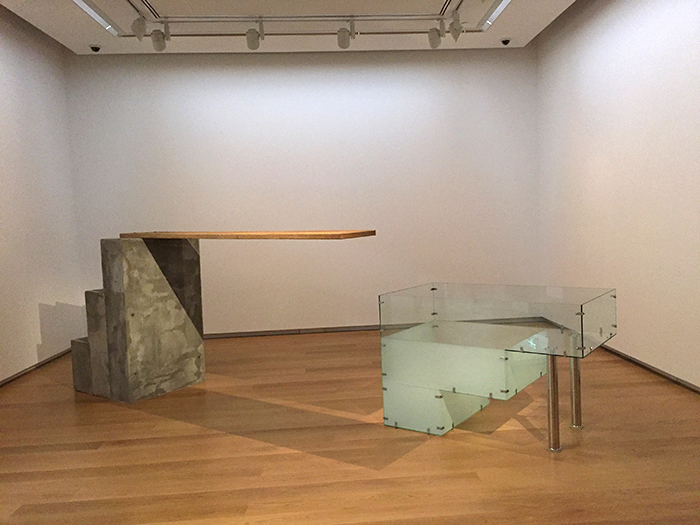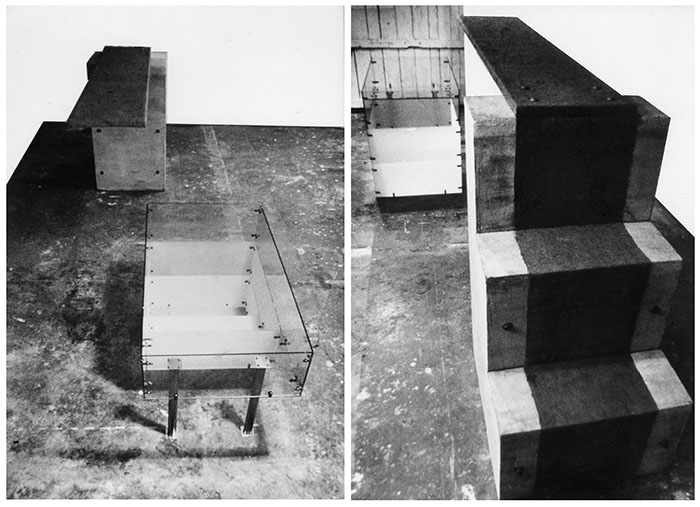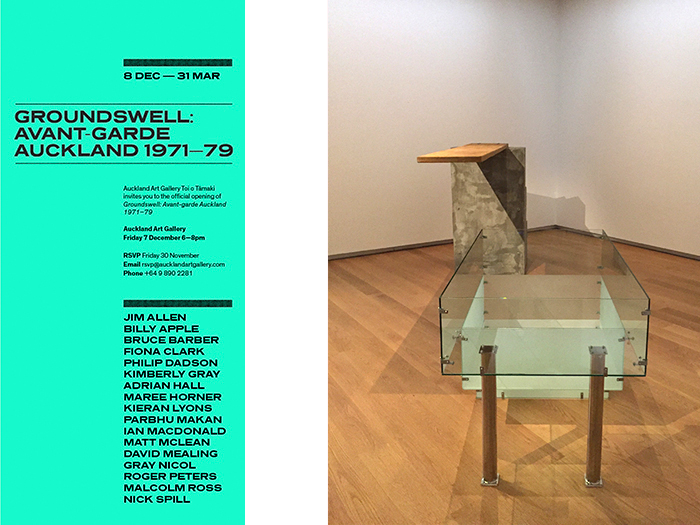DIVING BOARD
installation 1972 - 1998
 Groundswell: Avante-garde Auckland 1971-1979 - 2018-19
Groundswell: Avante-garde Auckland 1971-1979 - 2018-19

 All lines Converge - 2016-17
All lines Converge - 2016-17 Action replay: Post-Object Art - 1998
Action replay: Post-Object Art - 1998Photo credit: Bryan James, GBAG
 Diving board - 1972
Diving board - 1972
Diving board
Various media (concrete, laminated board, hessian, plate glass, stainless steel)
Included in various group exhibitions since 1998
The scene in which I find myself/or where does my body belong 2019-20
GBAG Collection as an artwork - Govett Brewster Art Gallery by artist Ruth Buchanan
![]()
Groundswell – Avante-garde Auckland 1971-1979
Auckland Art Gallery 2018-19
Diving board, Auckland Art Gallery
Groundswell Review ︎
![]()
All Line Converge 2016-17
Some Lines Through the Archive – Woman in (and out) or the archive
Govett Brewster Art Gallery ︎
All Lines Converge info ︎
Viewfinder 2006
Govett Brewster Art Gallery
Heatwave 2001
Govett Brewster Art Gallery
Action replay: Post-Object Art 1998
Govett Brewster Art Gallery
Diving board - 1972
new art - 1976
Diving board is primarily a visual statement that the spectator can confront and relate to in a direct physical sense, board to chest, and empty tank to groin. The 4'6" high concrete steps and the glass tank are linked across the space by the cantilevered hessian-covered board. The chest-neck board height gives the feeling of just about being out of one's depth; taking a decisive step and going by the board. The board erotically projects outwards just missing the tank. The glass tank is an obvious back-flipped reflection of the solid concrete steps. It also thrusts upwards and outwards then stops erect, on clean-cut stainless steel legs at thigh height. With cold formality three graduations of sand blasting matter-of-factly imply different water levels.(Carl A Mears)
Its literal existence evokes the preconceptions of the viewer about the object. I was interested in upsetting the preceiver by the strange scale, dryland format and the physical tensions of the materials against the implied activity around the image.
Various media (concrete, laminated board, hessian, plate glass, stainless steel)
Included in various group exhibitions since 1998
The scene in which I find myself/or where does my body belong 2019-20
GBAG Collection as an artwork - Govett Brewster Art Gallery by artist Ruth Buchanan

Groundswell – Avante-garde Auckland 1971-1979
Auckland Art Gallery 2018-19
Diving board, Auckland Art Gallery
Groundswell Review ︎

All Line Converge 2016-17
Some Lines Through the Archive – Woman in (and out) or the archive
Govett Brewster Art Gallery ︎
All Lines Converge info ︎
Viewfinder 2006
Govett Brewster Art Gallery
Heatwave 2001
Govett Brewster Art Gallery
Action replay: Post-Object Art 1998
Govett Brewster Art Gallery
︎ Acquired for the GBAG permanent collection, 1998 (note-date of original work should read 1972 on GBAG archives)
board section reconstructed – tank original
Diving board - 1972
new art - 1976
Diving board is primarily a visual statement that the spectator can confront and relate to in a direct physical sense, board to chest, and empty tank to groin. The 4'6" high concrete steps and the glass tank are linked across the space by the cantilevered hessian-covered board. The chest-neck board height gives the feeling of just about being out of one's depth; taking a decisive step and going by the board. The board erotically projects outwards just missing the tank. The glass tank is an obvious back-flipped reflection of the solid concrete steps. It also thrusts upwards and outwards then stops erect, on clean-cut stainless steel legs at thigh height. With cold formality three graduations of sand blasting matter-of-factly imply different water levels.(Carl A Mears)
Its literal existence evokes the preconceptions of the viewer about the object. I was interested in upsetting the preceiver by the strange scale, dryland format and the physical tensions of the materials against the implied activity around the image.
From:
new art
Some recent NZ sculpture and post-object art
edited by Jim Allen & Wystan Curnow
Pbl Heinemann (1976)